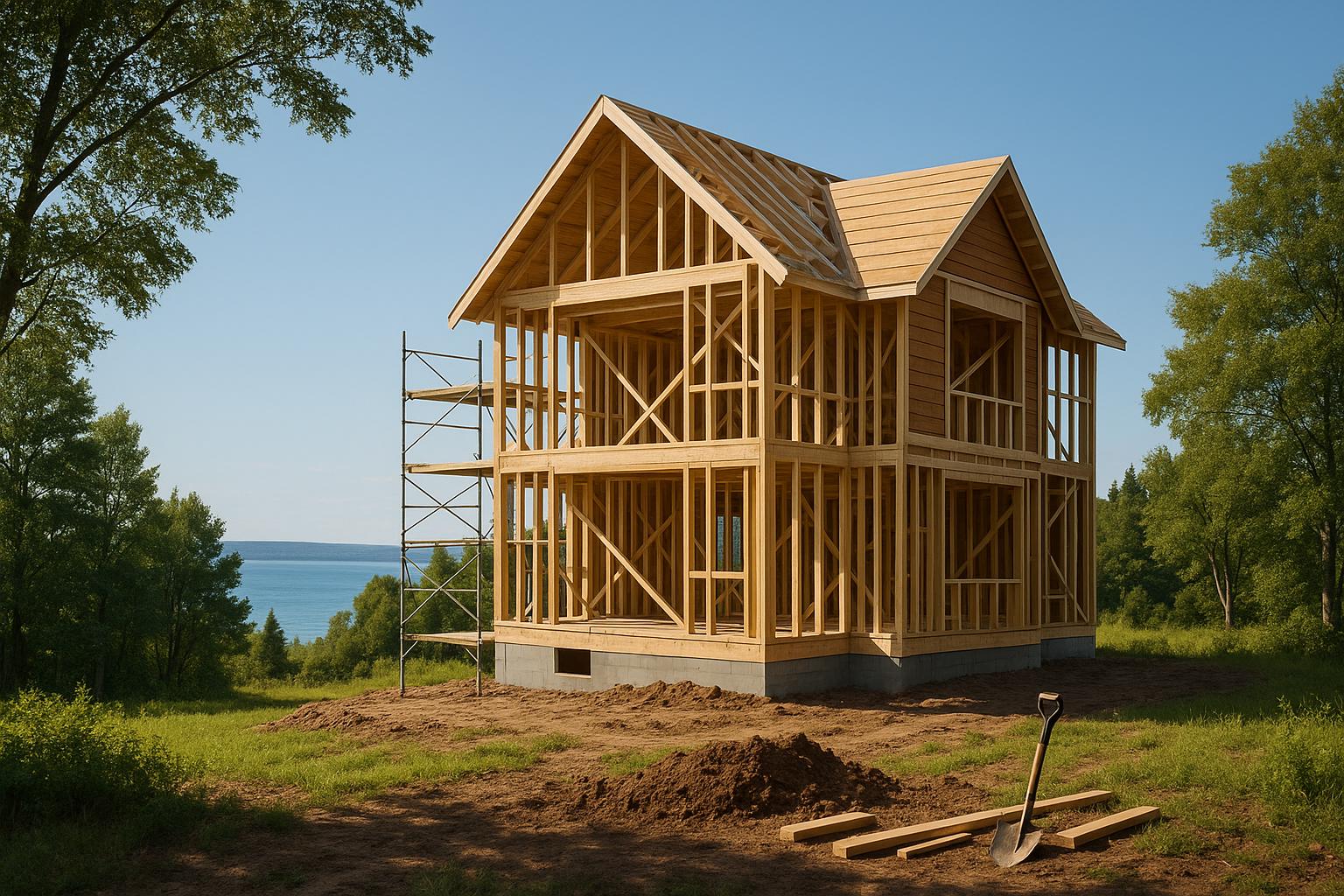Combining two lots in Nova Scotia's ER-3 zoning can significantly increase rental income and improve project efficiency. ER-3 zoning allows for higher-density residential developments like triplexes and townhomes, making it ideal for multi-unit projects. By merging adjacent lots, developers can build more units, reduce per-unit land costs, and achieve better returns compared to single-lot developments.
Key Takeaways:
- Single Lot: Typically supports 4–6 units, with monthly rental income of $7,800–$11,700.
- Two-Lot Assembly: Supports 10–14 units, with monthly income jumping to $19,500–$29,400.
- Cost Efficiency: Per-unit land costs drop by 14–20%, while annual ROI increases from 12–15% to 16–20%.
- Stability: Larger buildings reduce income loss from vacancies.
Land assembly also simplifies construction and financing, but success depends on early planning, local expertise, and navigating municipal regulations effectively.
#RealEstateTO: How to Execute A Successful Land Assembly And Development Strategy
How Land Assembly Works Under ER-3 Zoning
Understanding how land assembly operates within ER-3 zoning can help avoid unnecessary delays and expenses, making the process smoother and more efficient.
Land Assembly Basics and Process
Land assembly is the process of combining neighbouring properties to create a larger site for development. Under ER-3 zoning, this approach can unlock new opportunities for construction. Once combined, the properties are treated as a single legal parcel, enabling coordinated planning and better use of space. This step is key before diving into zoning and permit requirements.
The process starts by identifying adjacent properties that align in terms of size, terrain, and access. Factors like utility connections, drainage, and street access play a big role in evaluating whether properties are a good fit for assembly. The ultimate aim is to create a site that maximizes the number of permitted units while adhering to zoning rules.
In Nova Scotia, this process involves either a subdivision application or lot consolidation through the local municipality's planning system. For example, the Halifax Regional Municipality manages these applications via its online Permitting, Planning, Licensing & Compliance (PPLC) system [4]. This platform simplifies the application process and allows property owners to track their submissions throughout the approval process.
Zoning Rules and Requirements
ER-3 zoning comes with its own set of development standards that must be met before proceeding with land assembly. Each municipality in Nova Scotia has a Municipal Planning Strategy and Land Use By-law, which outline the specific requirements for ER-3 developments [3].
Key parameters include minimum lot sizes, setbacks from property lines, building height limits, and density rules [3]. These regulations vary depending on whether the project involves single-family homes or multi-unit buildings. Land assembly is particularly useful for projects aiming to maximize density within these guidelines.
There are three main pathways for development approval: "as of right" development (where all regulations are met), "site plan approval" (which includes design-specific conditions), and "Development Agreements" (customized legal contracts with negotiated terms) [3]. Most land assembly projects fall under the site plan approval category due to their complexity and scale.
If a project doesn’t meet the Land Use By-law requirements, property owners can apply for a variance. Common variance requests include adjustments to side yard setbacks or parking requirements, though approval isn’t guaranteed [3]. Consulting experienced professionals early in the process can help identify potential variance needs and address them proactively.
Municipal Planning and Permits
Navigating the municipal approval process for land assembly projects involves several steps and regulatory hurdles. Building officials may withhold permits until all conditions under the Heritage Property Act, Municipal Government Act, and other local bylaws are met. These include requirements related to land use, subdivision, lot grading, and development agreements [2].
Applications must include detailed plans and specifications that align with the National Building Code [2]. If requested, an updated plan of survey or real property report from a licensed Nova Scotia land surveyor may be needed to confirm compliance.
The Nova Scotia Building Code Regulations (NSBCR) incorporate the National Building Code of Canada 2020, National Energy Code of Canada for Buildings 2020, and National Plumbing Code of Canada 2020, along with specific provincial amendments [1]. These codes cover all aspects of design, construction, and occupancy for multi-unit projects.
Before construction can begin, municipal development officers must issue all necessary permits. This interconnected process highlights the value of working with integrated construction teams - groups that manage design, approvals, and construction under one roof. These teams can help avoid delays by ensuring all regulatory requirements are met upfront.
Approval timelines depend on the complexity of the project and the municipality involved. Land assembly projects, given their larger scope and density, often require more review time than single-lot developments. Engaging with municipal planners early can help identify and address potential hurdles, paving the way for a smoother approval process.
Yield Math: One Lot vs Two-Lot Assembly
When it comes to development under ER-3 zoning in Nova Scotia, combining two lots instead of developing a single lot can bring notable economic advantages. Let’s break down the numbers to see why land assembly often makes more financial sense.
Development Potential Comparison
In ER-3 zones, a single lot typically supports 4–6 rental units, depending on the lot size and municipal regulations. With current market rents for quality 2-bedroom apartments ranging between $1,950 and $2,100 per unit, this translates into monthly rental income of $7,800–$11,700.
Now, consider assembling two adjacent lots. This increases the development potential to 10–14 units, while still meeting setback and density rules. Monthly rental income for such a project jumps to $19,500–$29,400. Although construction costs are higher, the cost per unit remains steady. For instance, building 4–6 units on a single lot might cost $640,000–$960,000 (around $160,000 per unit). For 10–14 units on two lots, the total cost rises to $1.6–$2.24 million, but the per-unit cost holds at roughly $160,000. These figures highlight how assembling lots can amplify density and improve returns.
How Land Assembly Improves Density and ROI
Land assembly offers several efficiency benefits. With a larger footprint, developers can design smarter layouts, maximizing rentable space and minimizing wasted areas. Shared infrastructure - like walls, mechanical systems, and parking - further reduces costs.
The cost of land per unit also decreases with assembly. For example, if the combined land cost of two lots is $300,000, spreading that across 10–14 units results in a per-unit cost of $21,429–$30,000. This is a clear improvement over the $25,000–$37,500 per unit for single-lot projects.
Return on investment (ROI) also sees a boost. A single-lot project earning $93,600–$140,400 annually might deliver an ROI of 12–15%. Meanwhile, an assembled project generating $234,000–$352,800 annually could achieve a stronger ROI of 16–20%, assuming similar financing and operating expenses.
Additionally, larger developments are less vulnerable to vacancies. Losing one tenant in a 10–14 unit building reduces income by just 7–10%, compared to a 17–25% hit in a 4–6 unit property. This stability makes financing easier and reduces the financial strain of tenant turnover.
Single Lot vs Two-Lot Assembly Numbers
Here’s a side-by-side comparison to illustrate the benefits of land assembly under ER-3 zoning:
| Metric | Single Lot Development | Two-Lot Assembly | Advantage |
|---|---|---|---|
| Units | 4–6 units | 10–14 units | 133–150% increase |
| Monthly Rent | $7,800–$11,700 | $19,500–$29,400 | About 150% increase |
| Construction Cost | $640,000–$960,000 | $1,600,000–$2,240,000 | Consistent per-unit cost |
| Land Cost per Unit | $25,000–$37,500 | $21,429–$30,000 | 14–20% savings per unit |
| Annual ROI | 12–15% | 16–20% | 4–5 percentage points higher |
| Vacancy Impact | 17–25% income loss | 7–10% income loss | 50–60% less impact |
Larger properties also tend to attract better financing terms since lenders view them as more stable investments. Managing a single 10–14 unit building is often more cost-efficient than overseeing multiple smaller properties, as expenses like maintenance, snow removal, and landscaping can be consolidated.
Tax advantages also come into play. Larger projects often allow for better capital cost allowances and depreciation schedules. And timing matters - developers who acquire adjacent lots during slower market periods can negotiate lower purchase prices, further improving the project’s economics.
Financial Benefits of Land Assembly
Land assembly under ER-3 zoning can unlock new financial opportunities by increasing profitability and reducing risks. Let's dive into how it achieves this through higher returns, streamlined construction, and better risk management.
Boosting ROI with More Units
When you can spread fixed costs - like land acquisition or design fees - across a higher number of units, the per-unit cost drops significantly. This approach not only makes each unit more cost-effective but also stabilizes overall rental income. For instance, one vacancy has less impact when it represents a smaller fraction of your total rental portfolio. This scalability strengthens your financial position and aligns with the earlier quantitative advantages discussed.
Streamlined Construction with Integrated Teams
Traditional construction often involves juggling multiple players - architects, engineers, planners, and contractors - which can lead to miscommunication and delays. An integrated design-build model changes the game by bringing all these professionals together from the start. This eliminates a lot of the inefficiencies and can save property owners a hefty sum - about $47,000 in coordination costs.
Another big win? Time savings. With advanced scheduling and better collaboration, construction timelines that usually stretch 12–18 months can shrink to just six months, meaning rental income starts flowing faster. Plus, quality control improves since potential issues are spotted early, reducing costly mid-project changes.
Minimizing Risk with Fixed-Price Contracts
Fixed-price contracts are a financial safety net, locking in construction costs to keep budgets predictable and returns steady. Combined with the efficiency of integrated teams, this approach adds another layer of security. Contracts often include timeline guarantees with penalties - up to $1,000 per day - for delays, ensuring projects stay on track.
Additionally, having a single team handle the entire project simplifies warranty and insurance coverage. Instead of juggling multiple contractors' terms, property owners enjoy a single-source warranty, typically covering two years, for comprehensive peace of mind.
sbb-itb-16b8a48
How to Execute a Land Assembly Project
Turning a land assembly opportunity into a profitable rental property takes careful planning and the right team. Here’s a guide to help property owners navigate the process, from evaluating the opportunity to completing construction.
Step-by-Step Feasibility Assessment
The first step is identifying adjacent lots available for purchase within ER-3 zones. Once you’ve pinpointed the lots, begin with a financial analysis. Calculate the combined acquisition cost of the properties and determine how many units can be developed under ER-3 zoning rules. For example, acquiring two lots could allow for a fourplex or multiple townhomes, significantly increasing the number of units compared to a single-lot development.
Next, crunch the numbers on construction costs and projected rental income. If standard construction costs are $160,000 per unit, building a fourplex would cost around $640,000. With rental rates between $1,950 and $2,100 per month per unit, you could generate $7,800–$8,400 in monthly rental income, potentially yielding an annual ROI of 12–20%.
Check the zoning regulations with your local municipality to confirm the specific ER-3 rules for your chosen lots. Municipalities often have variations in setback requirements, height limits, and density rules, so this step is crucial to avoid costly surprises later in the process.
Don’t overlook site conditions. Factors like soil quality, drainage, access to utilities, and environmental concerns can significantly impact costs. Poor site conditions could increase expenses and reduce your ROI, so it’s essential to evaluate these early.
Once the feasibility is clear, the next step is to tackle common challenges and find ways to address them.
Common Problems and How to Avoid Them
One of the biggest hurdles in land assembly projects is managing multiple professionals, which can lead to miscommunication and delays. These delays, combined with cost overruns from fragmented project management or permitting issues, can eat into your returns. To avoid this, consider working with integrated teams and using fixed-price contracts to keep everything on track and within budget.
Quality control is another common issue, especially when multiple contractors are involved. A single-source accountability approach can simplify this. For example, having one construction team handle the entire project ensures consistent quality and often includes a two-year warranty on all work.
By addressing these potential pitfalls upfront, you can reduce risks and create a more predictable and profitable project outcome.
Working with Local Experts
In Nova Scotia, local expertise is invaluable. Municipal regulations can differ significantly between areas such as Halifax, Dartmouth, Bedford, and other communities within a 90-minute radius of Halifax, where ER-3 development opportunities are common.
Local professionals can simplify the permitting process by leveraging their established relationships with municipal staff and their knowledge of local procedures. Regional construction expertise is equally important. Builders familiar with Nova Scotia’s unique challenges - like sourcing materials locally, managing labour availability, and dealing with Maritime weather - are better equipped to handle the demands of your project.
Teams with strong relationships with local suppliers, tradespeople, and officials can resolve issues quickly and keep your project on schedule. A construction team with ongoing projects in multiple Nova Scotia municipalities is often best positioned to navigate these region-specific challenges.
Conclusion: ER-3 Land Assembly Results
The ER-3 land assembly approach opens up a promising avenue for property owners in Nova Scotia to significantly increase rental income and overall returns. The data speaks for itself - combining lots can deliver far greater benefits than single-lot development, both financially and operationally.
By merging two lots, you can effectively double the number of units, translating into a substantial boost in monthly rental income and an annual ROI ranging from 12% to 20%. With construction costs averaging $160,000 per unit, this strategy offers a compelling return on investment for those looking to maximize their property’s potential.
Beyond the financial upside, land assembly provides operational advantages. Using integrated design-build teams and fixed-price contracts helps avoid costly delays and unexpected expenses, ensuring projects stay on schedule and within budget. These efficiencies make the process smoother and more predictable.
However, the success of an ER-3 land assembly project depends heavily on conducting a detailed feasibility assessment and working with local experts. Navigating Nova Scotia’s municipal regulations - whether in Halifax, Dartmouth, or surrounding areas - requires a deep understanding of local policies to ensure the project is both viable and profitable.
FAQs
What advantages does working with an integrated construction team offer for ER-3 land assembly projects in Nova Scotia?
Using an integrated construction team for ER-3 land assembly projects in Nova Scotia offers several advantages that can make a big difference in project outcomes. It promotes smooth coordination between trades and ensures efficient project management - critical in markets where skilled labour is in short supply. This approach can help cut down on delays, accelerate timelines, and boost efficiency.
With streamlined communication and fewer risks from disconnected processes, an integrated team improves quality control and keeps unexpected costs in check. The result? Lower expenses and better profitability. For property owners developing multi-unit rentals under ER-3 zoning, this strategy can help maximize rental income while keeping the project on track.
How does ER-3 zoning in Nova Scotia make land assembly projects more viable for increasing unit density and design options?
ER-3 zoning in Nova Scotia gives property owners the opportunity to build up to eight units on a single lot, making it a great option for those considering duplexes, townhomes, or small apartment buildings. This zoning type allows for a range of design possibilities, making it easier to align with different project goals. Plus, if you combine multiple lots, you can increase the density even further, opening the door to larger multi-unit developments.
Another advantage of ER-3 zoning is its streamlined approval process. This can help shorten construction timelines and simplify the planning phase, which is a big win for developers. The ability to explore different multi-unit layouts not only meets local housing needs but also offers property owners a chance to optimize their investment.
What steps should property owners in Nova Scotia follow to meet municipal regulations and secure permits for ER-3 land assembly projects?
Navigating Municipal Regulations for ER-3 Land Assembly Projects in Nova Scotia
If you're tackling an ER-3 land assembly project in Nova Scotia, the first step is to dive into the local zoning bylaws. These bylaws will help you confirm whether your property meets the ER-3 requirements, such as minimum lot size and the number of allowable units. Your plans should also align with the Halifax Regional Municipality's specific land use guidelines and zoning criteria.
Once you've reviewed the zoning rules, it's time to prepare and submit a development permit application to your local planning office. Reaching out to municipal planning staff early in the process can be a game-changer. They can help clarify any requirements and flag potential roadblocks before they become bigger issues. Additionally, make sure your project complies with the Nova Scotia Building Code and any applicable regional planning strategies - this can save you from unnecessary delays.
To make the process even smoother, it’s worth consulting a professional who knows the ins and outs of local regulations. Their expertise can guide you through the approval process and ensure your project meets all required standards.



